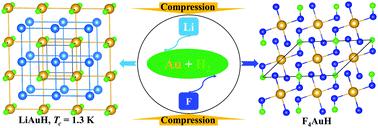当前位置:
X-MOL 学术
›
Phys. Chem. Chem. Phys.
›
论文详情
Our official English website, www.x-mol.net, welcomes your feedback! (Note: you will need to create a separate account there.)
Crystal structures and superconductivity of lithium and fluorine implanted gold hydrides under high pressures
Physical Chemistry Chemical Physics ( IF 3.3 ) Pub Date : 2021-08-27 , DOI: 10.1039/d1cp02781f Shoutao Zhang 1 , Qiuping Yang 1 , Xiaohua Zhang 1 , Kaixuan Zhao 1 , Hong Yu 1 , Li Zhu 2 , Hanyu Liu 3, 4
Physical Chemistry Chemical Physics ( IF 3.3 ) Pub Date : 2021-08-27 , DOI: 10.1039/d1cp02781f Shoutao Zhang 1 , Qiuping Yang 1 , Xiaohua Zhang 1 , Kaixuan Zhao 1 , Hong Yu 1 , Li Zhu 2 , Hanyu Liu 3, 4
Affiliation

|
The investigations on gold science have been capturing research interest due to its diverse physical and chemical properties. Gold hydrides in the solid state, as a member of the Au compound family, are rare since the reaction of Au with H is hindered in terms of their similar electronegativity. It is expected that Li and F can provide electrons and holes, respectively, to help stabilize gold hydrides under high pressure. Herein, by means of a crystal structural search based on particle swarm optimization methodology accompanied by first-principles calculations, four hitherto unknown Li–Au–H compounds (i.e., LiAuH, LiAu2H, Li2Au2H, and Li6AuH) are predicted to be stable under compression. Intriguingly, Au–H bonding is found in LiAuH, LiAu2H, and Li2Au2H. As the gold content increases, Au atom arrangements exhibit diverse forms, from the chain in Li6AuH, the square layer in LiAuH, the network in Li2Au2H, and eventually to the coexistence of square and pyramid layers in LiAu2H. Additionally, Li6AuH has a unique cage-type lithium structure. Furthermore, electron–phonon coupling calculations show that these Li–Au–H phases are phonon-modulated superconductors with a superconducting critical temperature of 1.3, 0.06, and 0.02 K at 25 GPa and 2.79 K at 100 GPa. In contrast, we also identified two solid F4AuH and F6AuH phases with unexpected semiconductivity. They have structural configurations of H-bridged AuF4 quasi-square components and distorted AuF6 octahedrons, respectively, and have no gold-to-hydrogen bonds. Our current results indicate that electron doping at suitable concentrations under pressure can stabilize unique gold hydrides, and provide deep insights into the structures, electron properties, bonding behavior, and stability mechanism of ternary Li–Au–H and F–Au–H compounds.
中文翻译:

高压下锂和氟注入的金氢化物的晶体结构和超导性
黄金科学的研究因其多样化的物理和化学特性而引起了研究兴趣。作为 Au 化合物家族的一员,固态的金氢化物很少见,因为 Au 与 H 的反应因其相似的电负性而受到阻碍。预计 Li 和 F 可以分别提供电子和空穴,以帮助在高压下稳定金氢化物。在此,通过基于粒子群优化方法的晶体结构搜索以及第一性原理计算,四种迄今为止未知的 Li-Au-H 化合物(即LiAuH、LiAu 2 H、Li 2 Au 2 H 和 Li 6AuH) 预计在压缩下是稳定的。有趣的是,在 LiAuH、LiAu 2 H 和 Li 2 Au 2 H 中发现了 Au-H 键。随着金含量的增加,Au 原子排列呈现出不同的形式,从 Li 6 AuH 中的链、LiAuH 中的方形层、 Li 2 Au 2 H 中的网络,最终导致 LiAu 2 H中方形和金字塔层的共存。此外,Li 6AuH 具有独特的笼型锂结构。此外,电子-声子耦合计算表明,这些 Li-Au-H 相是声子调制的超导体,其超导临界温度在 25 GPa 时为 1.3、0.06 和 0.02 K,在 100 GPa 时为 2.79 K。相比之下,我们还发现了两种具有意外半导体性的固体 F 4 AuH 和 F 6 AuH 相。它们具有 H 桥接 AuF 4准方形元件和扭曲的 AuF 6 的结构配置分别是八面体,并且没有金-氢键。我们目前的结果表明,在压力下适当浓度的电子掺杂可以稳定独特的金氢化物,并深入了解 Li-Au-H 和 F-Au-H 三元化合物的结构、电子特性、键合行为和稳定机制。
更新日期:2021-09-22
中文翻译:

高压下锂和氟注入的金氢化物的晶体结构和超导性
黄金科学的研究因其多样化的物理和化学特性而引起了研究兴趣。作为 Au 化合物家族的一员,固态的金氢化物很少见,因为 Au 与 H 的反应因其相似的电负性而受到阻碍。预计 Li 和 F 可以分别提供电子和空穴,以帮助在高压下稳定金氢化物。在此,通过基于粒子群优化方法的晶体结构搜索以及第一性原理计算,四种迄今为止未知的 Li-Au-H 化合物(即LiAuH、LiAu 2 H、Li 2 Au 2 H 和 Li 6AuH) 预计在压缩下是稳定的。有趣的是,在 LiAuH、LiAu 2 H 和 Li 2 Au 2 H 中发现了 Au-H 键。随着金含量的增加,Au 原子排列呈现出不同的形式,从 Li 6 AuH 中的链、LiAuH 中的方形层、 Li 2 Au 2 H 中的网络,最终导致 LiAu 2 H中方形和金字塔层的共存。此外,Li 6AuH 具有独特的笼型锂结构。此外,电子-声子耦合计算表明,这些 Li-Au-H 相是声子调制的超导体,其超导临界温度在 25 GPa 时为 1.3、0.06 和 0.02 K,在 100 GPa 时为 2.79 K。相比之下,我们还发现了两种具有意外半导体性的固体 F 4 AuH 和 F 6 AuH 相。它们具有 H 桥接 AuF 4准方形元件和扭曲的 AuF 6 的结构配置分别是八面体,并且没有金-氢键。我们目前的结果表明,在压力下适当浓度的电子掺杂可以稳定独特的金氢化物,并深入了解 Li-Au-H 和 F-Au-H 三元化合物的结构、电子特性、键合行为和稳定机制。



























 京公网安备 11010802027423号
京公网安备 11010802027423号